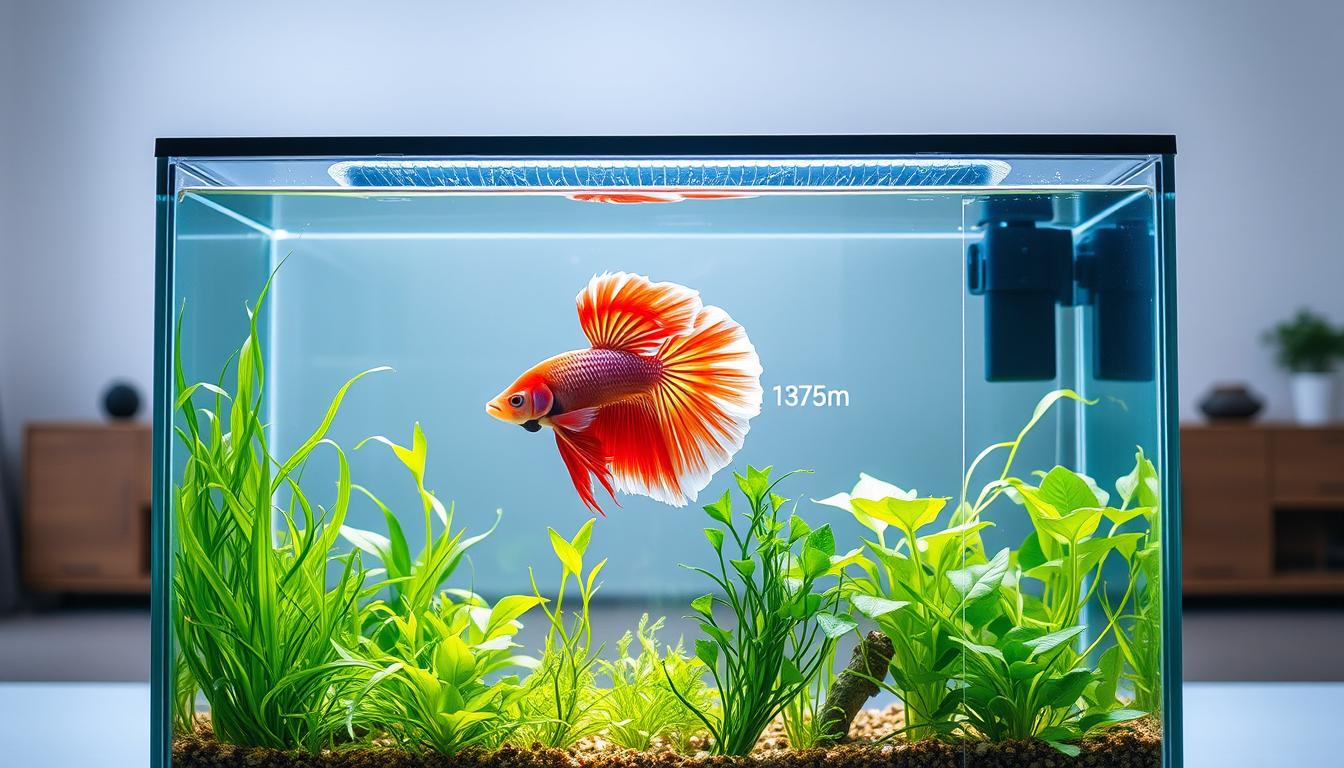If you’re a new betta owner or planning to get one soon, you’ve probably asked yourself: how big of a tank does a betta fish need? Despite the common myth that bettas can thrive in tiny bowls, the truth is they need more space than most people think. Bettas are active, curious fish that love to explore, hide, and swim.
A cramped container can lead to stress, poor water quality, and even a shortened lifespan. In this guide, we’ll break down exactly how big of a tank does a betta fish need and why giving them more room is one of the best things you can do for their health and happiness.
Many people believe that Betta fish can thrive in small containers, but this couldn’t be further from the truth! In reality, providing a suitable environment is crucial for their health and happiness. So, what’s the perfect tank size for your Betta?
We’re here to settle the debate once and for all! In this article, we’ll explore the ideal betta fish tank requirements and why tank size matters. Let’s dive in and find out what you need to know!
Key Takeaways
- Discover the ideal tank size for Betta fish
- Learn why tank size matters for Betta health
- Understand the importance of providing a suitable environment
- Get tips on creating a happy and healthy Betta habitat
- Find out how to choose the right tank for your Betta
The Truth About Betta Fish Housing
If you’re like many Betta owners, you might be surprised to learn the truth about their housing needs. Many of us have been misinformed about the kind of environment Betta fish thrive in. Let’s set the record straight and explore the common misconceptions about Betta fish tanks and why tank size really matters for their health and happiness.
Common Misconceptions About Betta Fish Tanks
One of the most prevalent myths is that Betta fish live in tiny puddles in the wild. However, their natural habitats are actually densely vegetated, slow-moving waters. In fact, studies have shown that Betta fish can thrive in territories of around 11 gallons in the wild! This contradicts the common practice of keeping them in small tanks or bowls.
Why Tank Size Matters for Betta Health and Happiness
The size of a Betta’s tank directly impacts their health and happiness. A larger tank provides a more stable environment, with better water quality and reduced stress. Here’s a comparison of how different tank sizes can affect Betta fish:
Read Also Gas Bubble Disease in Betta Fish: Causes, Symptoms & Treatment Guide
| Tank Size | Water Quality | Betta Health |
|---|---|---|
| Small (less than 2.5 gallons) | Prone to fluctuations | High stress, disease prone |
| Medium (5 gallons) | More stable | Better health, active |
| Large (10 gallons or more) | Very stable | Optimal health, thriving |
As you can see, a larger tank size is crucial for maintaining optimal water quality and ensuring your Betta fish leads a healthy, happy life.
How Big of a Tank Does a Betta Fish Need?
Determining the right tank size for your Betta fish can be a bit tricky, but don’t worry, we’ve got you covered! The size of the tank is crucial for the health and happiness of your Betta. While some sources recommend a minimum tank size of 2.5 gallons, we believe that 5 gallons is a more suitable size for Betta fish.
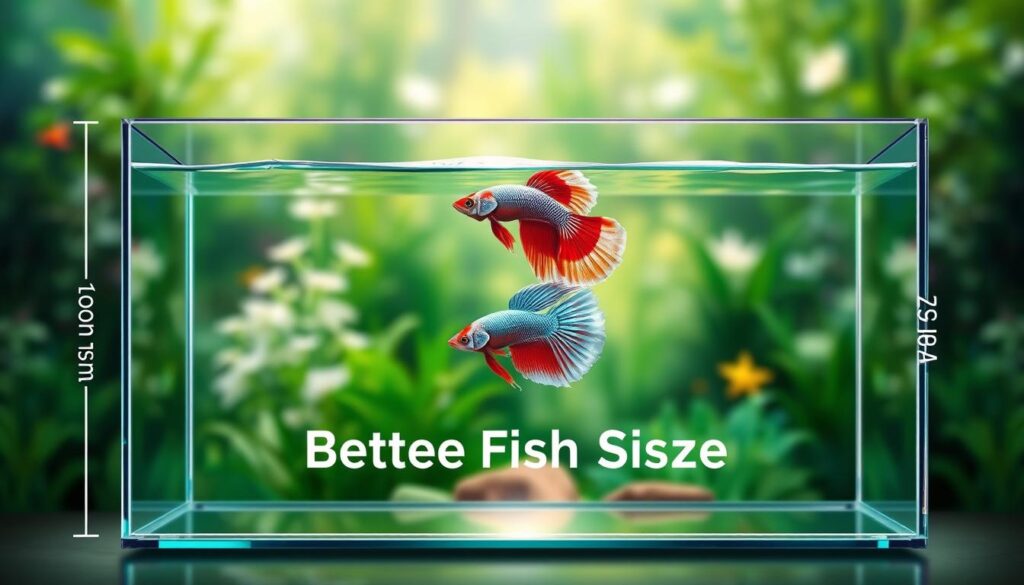
Minimum Tank Size Requirements
The minimum tank size for Betta fish is a topic of much debate. While 2.5 gallons is often cited as the minimum, we recommend starting at 5 gallons. This larger size provides a more stable environment, which is easier to maintain and offers your Betta fish ample space to swim.
A 5-gallon tank is not just about giving your Betta room to swim; it’s also about creating a thriving ecosystem. With a larger tank, you can include more decorations and hiding places, which are essential for reducing stress and promoting healthy behavior in your Betta.
Ideal Tank Size for Optimal Health
For optimal health, a tank size of 5 gallons or more is ideal. This size tank offers numerous benefits, including improved water quality and stability, enhanced swimming space, and reduced stress.
| Tank Size | Benefits |
|---|---|
| 2.5 gallons | Minimum recommended size, but can be challenging to maintain stable water conditions. |
| 5 gallons | Ideal for Betta fish, offering a stable environment and ample swimming space. |
| 10 gallons or more | Provides maximum stability and space for decorations and tank mates. |
Understanding Betta Fish Natural Habitat
Betta fish are native to the slow-moving waters of Thailand. In their natural habitat, they inhabit areas with dense vegetation and plenty of hiding spots. Mimicking this environment in your tank can help keep your Betta happy and healthy.
By understanding the natural habitat of Betta fish, you can make informed decisions about tank size, decorations, and overall setup. This knowledge will help you create a thriving environment that meets your Betta’s needs.
The Dangers of Small Tanks and Bowls
When it comes to housing your Betta fish, size really does matter! We’ve all seen those tiny Betta bowls at pet stores, but are they really suitable for our finned friends? Unfortunately, the answer is no.
Small tanks and bowls can lead to a range of health issues for your Betta. Let’s take a closer look at some of the problems caused by inadequate space.
Health Issues Caused by Inadequate Space
Keeping your Betta in a small tank can result in health issues such as obesity, fatty liver disease, and stress. When Bettas don’t have enough space to swim, they can become lethargic and prone to these conditions. A larger tank provides the space your Betta needs to stay active and healthy.
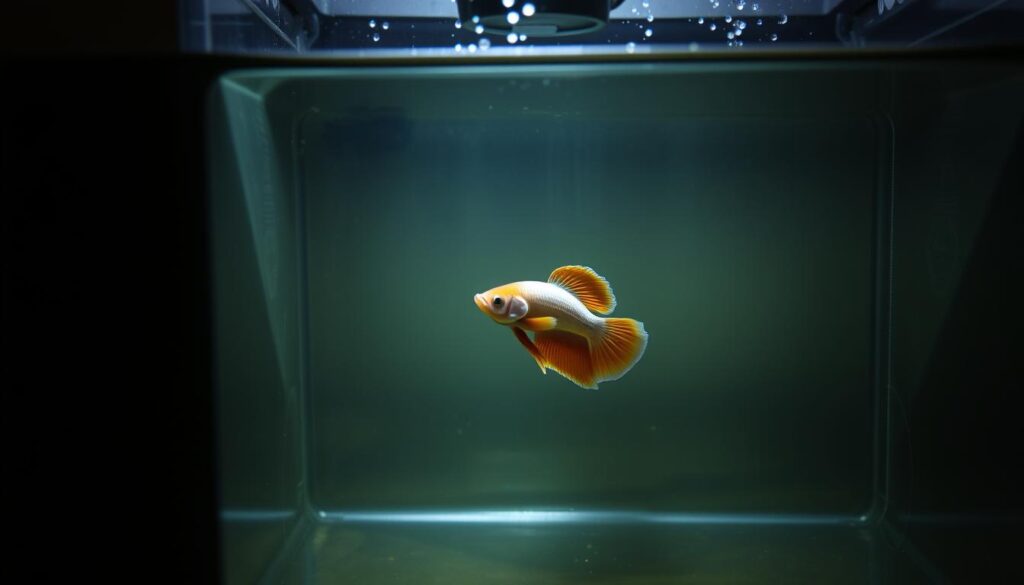
The Myth of Bettas Thriving in Small Spaces
Many people believe that Betta fish thrive in small spaces, but this is a misconception. In the wild, Bettas inhabit rice paddies and slow-moving streams, which can be quite spacious. By providing a larger tank, you’re giving your Betta a more natural environment.
Impact of Small Tanks on Betta Lifespan
The lifespan of a Betta fish can be significantly impacted by the size of its tank. In small tanks, Bettas often have shorter lifespans due to the health issues mentioned earlier. By upgrading to a larger tank, you can help your Betta live a longer, healthier life.
In conclusion, it’s clear that small tanks and bowls are not the best choice for your Betta fish. By choosing a larger tank, you’re giving your Betta the best chance to thrive. So, consider upgrading your Betta’s home today and watch them flourish!
Benefits of Larger Tanks for Betta Fish
A larger tank is not just a luxury for Betta fish; it’s a necessity for their well-being. By providing a spacious environment, you’re giving your Betta the best chance to thrive. So, what makes larger tanks so beneficial?
Improved Water Quality and Stability
Larger tanks offer improved water quality and stability, which is crucial for your Betta’s health. With more water volume, the tank is less susceptible to sudden changes in water parameters, making it easier to maintain a stable environment. This means fewer water changes and less stress on your fish!
A bigger tank also allows for a more efficient filtration system, which helps to keep the water clean and clear. This is especially important for Betta fish, as they’re sensitive to water quality. By maintaining good water quality, you’re helping to prevent health issues and keep your Betta happy.
Enhanced Swimming Space and Natural Behavior
Betta fish are natural swimmers and need room to move around. A larger tank provides enhanced swimming space, allowing your Betta to exhibit its natural behavior and exercise freely. This is essential for maintaining their physical and mental health.
- More space to swim and play
- Opportunities to explore and interact with their environment
- Reduced boredom and stress
Reduced Stress and Disease Prevention
By providing a larger tank, you’re helping to reduce stress and prevent disease in your Betta fish. A spacious environment means less competition for resources and reduced aggression. Plus, a stable and clean environment helps to boost your Betta’s immune system, making them less susceptible to illness.
So, if you want to give your Betta fish the best life possible, consider upgrading to a larger tank. Your finned friend will thank you!
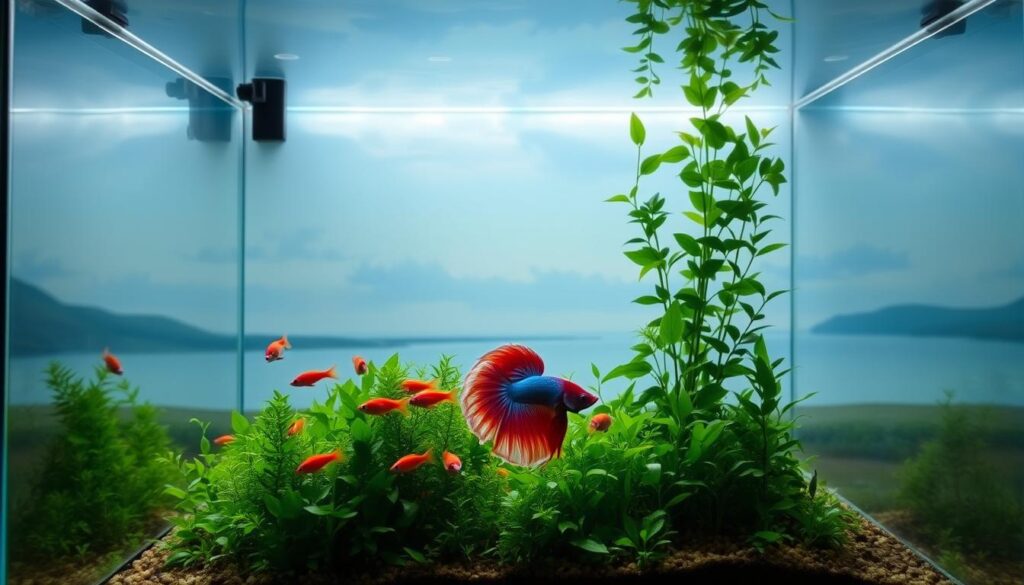
Choosing the Right Tank Shape and Dimensions
When it comes to housing your Betta fish, the shape and size of the tank can make all the difference! You want to create a comfortable and thriving environment for your finned friend, and that starts with understanding their needs.
Betta fish are naturally adapted to swimming in slow-moving waters with plenty of vegetation. By providing a tank that mimics their natural habitat, you’re giving your Betta the best chance to thrive.
Horizontal vs. Vertical Tanks
For Betta fish, horizontal tanks are generally preferred over vertical tanks. This is because they allow for more surface area and provide a more natural environment for your Betta to swim and explore.
Vertical tanks, on the other hand, can be limiting for Bettas. They tend to swim near the surface, so a tall, narrow tank doesn’t provide the same level of comfort as a wider, more horizontal tank.
Surface Area Considerations
Betta fish are labyrinth fish, which means they need access to the surface to breathe. A tank with a large surface area provides your Betta with the oxygen they need to thrive.
When choosing a tank, look for one with a wide mouth and plenty of surface area. This will help ensure your Betta has access to the oxygen they need.
Recommended Tank Dimensions for Bettas
So, what’s the ideal tank size and shape for a Betta fish? Here are some guidelines:
| Tank Size | Dimensions | Surface Area |
|---|---|---|
| 5 gallons | 16x8x10 inches | 128 sq. inches |
| 10 gallons | 20x10x12 inches | 200 sq. inches |
| 20 gallons | 24x12x16 inches | 288 sq. inches |
As you can see, a larger tank with a wider mouth provides more surface area for your Betta to thrive. When choosing a tank, consider the dimensions and surface area to ensure you’re providing the best environment for your Betta fish.
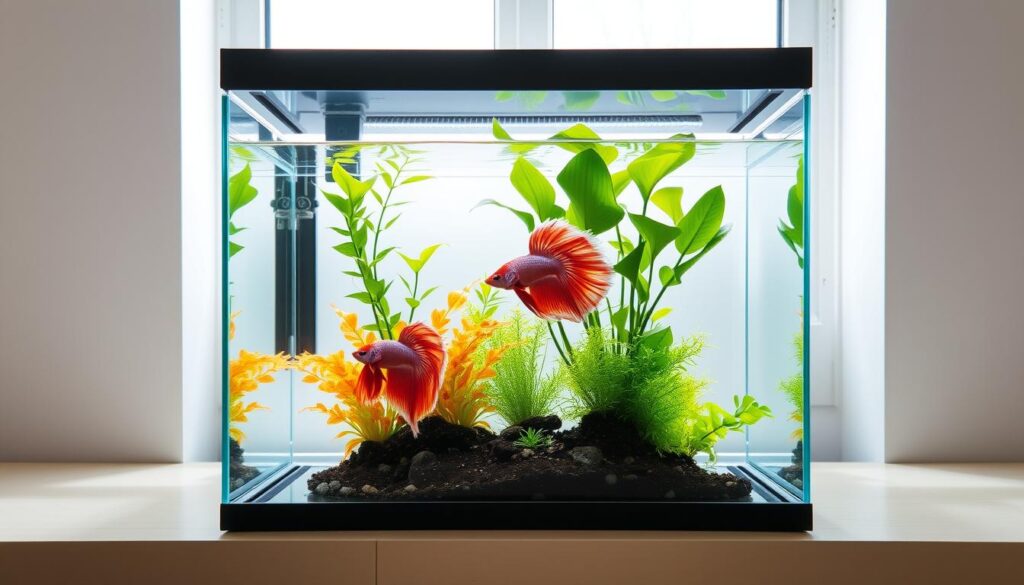
Setting Up Different Sized Betta Tanks
When it comes to setting up a Betta tank, size really does matter! The right tank size can make all the difference in your Betta’s health and happiness. Let’s explore the pros and cons of different tank sizes, from 2.5 gallons to 10 gallons or more.
2.5-Gallon Tank Setup
A 2.5-gallon tank is a good starting point for Betta keepers, especially those with limited space. It’s compact, easy to maintain, and can be a great introduction to the world of aquarium keeping.
Pros and Cons of 2.5-Gallon Tanks
The pros of a 2.5-gallon tank include its affordability and space-saving design. However, the cons include limited swimming space for your Betta and potentially unstable water parameters.
5-Gallon Tank Setup
A 5-gallon tank is often considered the sweet spot for Betta keepers. It provides a good balance between space efficiency and water stability, making it easier to maintain a healthy environment for your Betta.
Pros and Cons of 5-Gallon Tanks
The pros of a 5-gallon tank include better water stability and more swimming space for your Betta. While it’s still a relatively small tank, it offers more flexibility in terms of decorations and equipment. The cons are relatively few, but it does require a bit more space and initial investment.
10-Gallon and Larger Tank Setup
For those who want to go all out, a 10-gallon or larger tank can provide a thriving environment for your Betta. These tanks offer ample swimming space, stable water parameters, and the flexibility to create a complex aquascape.
Setting up a larger tank requires more space, equipment, and maintenance effort, but the rewards can be significant. Your Betta will have plenty of room to swim, and you can enjoy a beautiful, diverse aquarium.
Essential Equipment for Various Tank Sizes
Setting up a Betta tank requires careful consideration of the equipment needed to create a stable and thriving environment. Regardless of tank size, proper equipment is essential for maintaining a healthy environment.
Filtration Requirements by Tank Size
Filtration is crucial for keeping the water clean and healthy for your Betta. For smaller tanks (2.5-5 gallons), a gentle filter is recommended to avoid creating strong currents that can stress your Betta. For larger tanks (10 gallons and up), you can opt for more powerful filters that can handle the increased water volume.
Here’s a quick overview of filtration requirements by tank size:
| Tank Size | Filtration Recommendation |
|---|---|
| 2.5-5 gallons | Gentle filter (e.g., sponge filter) |
| 5-10 gallons | Moderate filter (e.g., hang-on-back filter) |
| 10 gallons and up | Powerful filter (e.g., canister filter) |
Heating Systems and Temperature Stability
Bettas are tropical fish that thrive in warm water between 76-82°F (24-28°C). For tanks smaller than 5 gallons, a compact heater is sufficient. Larger tanks require more powerful heaters to maintain a stable temperature.
Key considerations for heating systems:
- Choose a heater that’s suitable for your tank size.
- Use a thermometer to monitor the temperature.
- Avoid placing heaters near the tank’s surface to prevent temperature fluctuations.
Lighting Considerations for Different Setups
Lighting can enhance the appearance of your Betta tank and promote plant growth. For planted tanks, consider using LED grow lights that provide the necessary spectrum for plant development. For tanks without plants, low-wattage lighting can help create a visually appealing environment.
By choosing the right equipment for your Betta tank, you can create a thriving environment that meets your fish’s needs. Remember to consider the specific requirements for your tank size to ensure the health and happiness of your Betta.
Read Also Betta Fish Spitting Food? Causes & Fixes
Decorations and Aqua scaping Based on Tank Size
When it comes to decorating your Betta fish tank, the size of your tank plays a crucial role in determining the right aqua scaping approach! Decorations and aqua scaping can greatly impact the health and happiness of your Betta fish. By adding plants, hiding places, and other decorations, you can create a thriving environment that meets the needs of your Betta.
Plants and Hiding Places for Small Tanks
In small tanks (2.5 gallons or less), it’s essential to keep decorations simple and uncluttered. Choose a few hardy plants like Java Moss or Anubias that can thrive in smaller spaces and provide your Betta with hiding places. Some great options include:
- Small potted plants
- Rock caves
- Driftwood
These decorations not only enhance the visual appeal of your tank but also help reduce stress in your Betta fish.
Creating Territories in Medium Tanks
Medium tanks (5-10 gallons) offer more flexibility for aquascaping. You can create separate territories for your Betta by using plants, rocks, and other decorations to divide the tank. Consider adding:
- Tall plants like Amazon Swords
- Rock formations
- Tunnel decorations
This will not only keep your Betta engaged but also provide a more natural environment.
Complex Environments in Large Tanks
In large tanks (10 gallons or more), you can create complex environments with a variety of decorations and plants. Consider adding a mix of:
- Floating plants like Water Wisteria
- Background plants like Java Fern
- Rocks and driftwood
This will create a dynamic and engaging environment for your Betta, promoting natural behavior and reducing stress.
Tank Mates and Community Setups Based on Tank Size
When it comes to keeping Betta fish with other fish, the size of your tank is crucial! A well-planned community tank can be a wonderful way to keep your Betta fish happy and entertained. But, it’s essential to choose the right tank size and tank mates to avoid conflicts.
Compatible Tank Mates for 5-Gallon Tanks
In a 5-gallon tank, you’ll want to keep the number of tank mates limited. Some compatible options include Neon Tetras and Harlequin Rasboras. These fish are peaceful, small, and can thrive in a well-maintained 5-gallon tank. Avoid fin-nippers and aggressive fish that might harass your Betta!
Compatible Tank Mates for 10-Gallon Tanks
A 10-gallon tank offers more flexibility when it comes to choosing tank mates. You can consider adding a small school of Corydoras Catfish or Zebra Danios. These fish are generally peaceful and can coexist with your Betta fish. Just remember to provide plenty of hiding places and plants to reduce stress!
Community Setup in 20-Gallon and Larger Tanks
In a 20-gallon or larger tank, you can create a thriving community with a variety of fish. Consider adding Gouramis, Platies, or Swordtails to your tank. With a larger tank, you’ll have more flexibility to create a diverse and engaging environment for your Betta fish and its tank mates. Just be sure to research the specific needs of each species and plan accordingly!
By choosing the right tank size and tank mates, you can create a harmonious and engaging community tank that will keep your Betta fish happy and healthy. Happy aquarium keeping!
Conclusion
Now that we’ve explored the ins and outs of Betta fish tank size, it’s clear that providing the right environment is crucial for your fish’s health and happiness. So, how big of a tank does a Betta fish need? While the minimum tank size is 2.5 gallons, we recommend opting for a larger tank to ensure optimal water quality and stability.
When it comes to betta fish tank size, bigger is often better. A larger tank provides ample swimming space, reduces stress, and allows for a more natural environment. By choosing the right betta fish tank requirements, you can create a thriving ecosystem that will keep your Betta happy and healthy.
By considering the needs of your Betta fish and making informed decisions about their care, you can build a rewarding and enjoyable hobby. Happy Betta keeping!
Read Also Betta Fish Food Guide: Optimal Feeding Amounts

